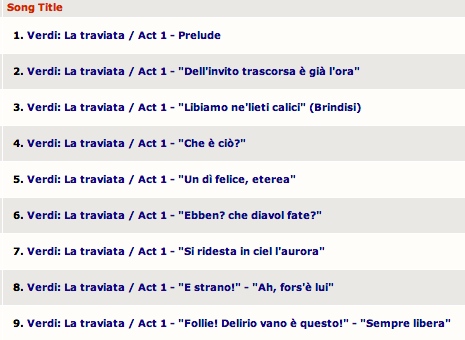
Online Music is Obscuring Opera
HumourAs I sat for the nth time scrolling through my music library on my computer, trying to find that really cool bit between this aria and that finale, I switched from recording to recording, hoping that the track division would be different, and perhaps more conducive to my finding that super neat chord progression. And it took me so long to find the thing that my determination wilted. It was somewhere in that chunk of 9:41 or something, and, sure that I had combed through every second of that stupid clip in vain, I was experiencing an acute sensation of oncoming dementia.
But I realized that the problem is quite simple: online music has no idea what to do with classical music. And all I’m talking about is how the album information is displayed. For example: you want to listen to part of Mozart’s Requiem. When you pull up the album, this is what you see:

Helpful. Or, you search for a recording of Wagner’s Ring Cycle. On iTunes, you get this:

This search was for “songs,” with the search terms “wagner ring nibelung.” You get a list of tracks from at least three different albums, one of them not a recording of any of the four operas, and the tracks are out of order. None of this matters if you’re talking about mainstream commercial music. If you’re searching for Bob Dylan, for example, the order of the songs or what album they’re on isn’t important for an accurate search result.
It’s only a problem because the form used by online music services doesn’t work for classical music or opera. Case in point, in the details for a DVD of Le nozze di Figaro:

Writers. Writers. I don’t know why that’s so offensive. It’s sort of like calling Frank Lloyd Wright a sketch artist. I mean, he sketches, but, come on.
Another example: at barnesandnoble.com, I filtered my search for Music > Opera and Vocal > Opera. I got a list of anthology-type albums, and the first complete work isn’t even an opera:

I also checked out streaming services, including Rdio, Songza, Grooveshark and Jango. I found another culprit: automated playlists. Check out Grooveshark’s search results for “la traviata:”

It’s a freaking mess.
Over at Songza.com, I tried searching opera through their playlist system. Here’s what I got:

And when I checked out the Italian Cooking: Opera playlist (good title), the first song I got was “Voi che sapete.” Now, I get that tagging and probably an algorithm or two determines what kind of stuff ends up on these playlists, and it was clear that the criteria were limited to the terms “Italian” and “opera.” Fair. But an aria about puberty is not good cooking music.
It’s not even that the content is bad. On Rdio I heard an insanely good live recording that (I didn’t recognize) of “Che gelida manina…”, but the stupid player was stuck on the previous “song’s” track info. I’ll never find out who it was. Sigh. It continued into someone’s woofy rendition of “Se vuol ballare,” which was apparently on an album that included the subsequent recitative in the same track. Secco recit: also not good cooking music.
What to do? It boils down to having someone around the offices at iTunes, Songza, etc., to consult on opera and classical music. It doesn’t fit the same form as commercial music, and it says a lot about the online music industry that they don’t seem to know how off-base they are.
Wouldn’t it be neat if the track listings for an opera album gave you an idea of where you were in the story? Like for La traviata, instead of this:

This:
- The scene where everybody drinks.
- Alfredo professes his love.
- Violetta’s gotta be free.
- Their fake honeymoon.
- Dad’s guilt-trip.
- Family conflict.
- Misguided emotions.
- Health problems.
- Reunion, too little too late.
Of course I’m being a brat about it, but if we had even a semblance of checkpoints like these in the track listings of opera albums, scrolling through to find where you are would be no biggie. And the artists involved should be searchable: if you’ve got Mirella Freni singing Mimì, you should be able to find her individually in each track in which Mimì sings. You’d be able to find Cherubino’s part in the busiest Mozart finale by filtering the artist’s name. Having the full name of the conductor and the orchestra (and sometimes the chorus) as a precursor to each scene’s list of singers is respectable, but renders any mobile device useless when you’re looking for the duet in Act II. Of course, I don’t yet have the means to make this revolution happen. So this post is officially a rant. For another angle on the topic, check out Molly Sheridan’s article at New Music Box.
In the meantime, enjoy the hours spent in your iTunes libraries, tediously re-labelling every track in La bohème.


Comments